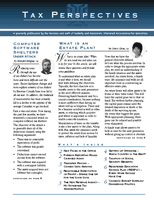
PDF Format
 Issue Contents Issue Contents
 All Issues All Issues
October 1997
Registered Education Savings Plan ("RESP's") — Every Home Should Have One
By Howard L. Wasserman, CA, CFP, TEP
Cadesky and Associates LLP (Toronto)
The February 1997 Federal Budget introduced a number of favourable changes to RESP's. They are well worth considering, to fund a child's university education in a tax-effective way. What is a RESP A RESP is a plan whereby an individual (usually a parent or grandparent) makes contributions towards a fund for a minor's university education. The beneficiaries of the RESP can receive these contributions, plus the income accumulated on the contributions, upon being admitted to a post-secondary institution. RESP's provide two tax advantages; tax deferral and income-splitting. Contributions Unlike RRSP's, contributions to a RESP are unfortunately not tax deductible. However, the capital is not taxable upon withdrawal. The income earned by the RESP is not taxed until it is withdrawn by the student (hence the tax deferral). Since most students have little or no income and can take a tax credit for tuition fees, the taxes on the income withdrawals can be very small (hence the income-splitting). From January 1997, the annual limit on contributions to RESP's has been increased from $2,000 to $4,000 per child. Therefore, if a couple has three children, they could contribute up to $12,000 each year to an RESP. However, there is a total contribution limit of $42,000 per beneficiary. Withdrawal of Capital & Income In the past, if no child in the family attended post-secondary education, the income earned on the contributions was lost. Because of this, many people were reluctant to contribute to an RESP. To address this concern, if all intended beneficiaries do not pursue higher education by age 21, and the plan has been running for at least ten years, a contributor resident in Canada can withdraw the income from the plan as well as the capital. However, it will be taxable, together with a 20% additional tax. In certain cases, the income can be transferred to an RRSP, thereby avoiding the penalty tax. Conclusion RESP's have become more attractive as a consequence of the above changes. Take note that such plans accumulate income without tax. But there are many types of RESP's and one should make a detailed review of the plans that exist before investing. Since there are very few simple and effective ways to income split with minor children, we suspect RESP's will become more popular now that they are more user-friendly.
|